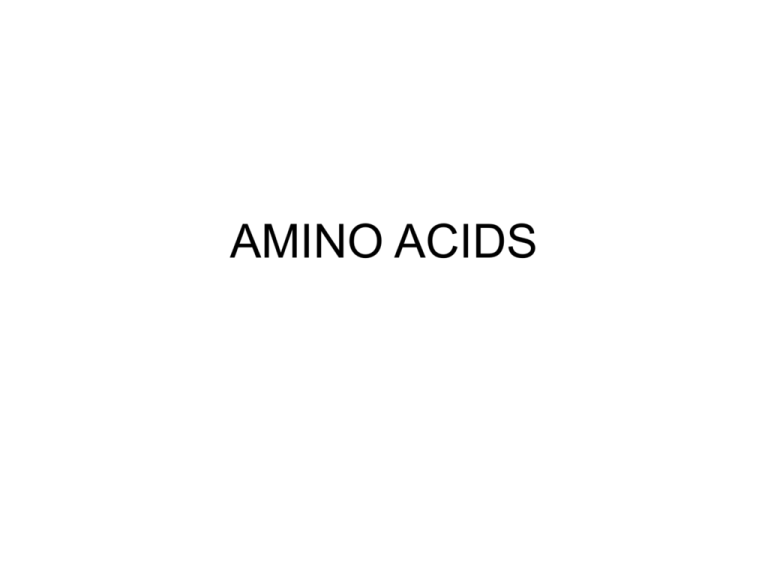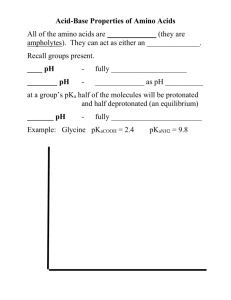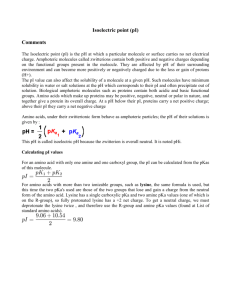AMINO ACIDS
advertisement

AMINO ACIDS Amino Acids are the building blocks of Proteins • Composed of C, H, O, N usually S, P • Always has a NH2 General Structure • All amino acids start with this structure • The “R” stands for “anything” Glycine • Glycine has just a hydrogen for the “R” • NOT essential, except for the baby chick Alanine • Alanine has a methyl group for the “R” • Has 3 carbons (glycine had just 2) • NOT essential Serine • NOT essential Threonine • Essential Valine • Essential • Valine is a branched chain amino acid. • An "ideal protein" would contain 70% as much isoleucine as lysine. • A rare, inherited metabolic disease in which there is a failure of oxidative decarboxylation (breakdown) of valine, leucine and isoleucine results in maple syrup urine disease, named because of a characteristic odor of the urine. Leucine • Leucine is abundant in corn protein and many other grain proteins, and is not therefore a concern to supplement. Only the L isomer has biological value. "Ideal protein" would contain 100% as much leucine as lysine. Isoleucine • Isoleucine is a branched chain amino acid. An "ideal protein" would contain one-half as much isoleucine as lysine. • A rare, inherited metabolic disease in which there is a failure of oxidative decarboxylation (breakdown) of valine, leucine and isoleucine results in maple syrup urine disease, named because of a characteristic odor of the urine. Phenylalanine • Phenylalanine is not tolerated by people with inborn errors of PHE metabolism so they must avoid it. Babies are given a PKU (phenylketonuria) test at birth to detect phenylalanine metabolites in the urine, so they can be treated in order to avoid a dangerous condition. • PHE is combined with ASP (aspartic acid, another amino acid) in the common non-nutritive sweetner aspertame. Equal is another trade name. Methionine • Methionine is a sulfur-containing amino acid. • A portion of the methionine requirement can be met from cystine, another sulfurcontaining amino acid. • An "ideal protein" would contain onehalf as much methionine + cystine as lysine. • Unlike most amino acids, both the d and l isomers of methionine are biologically active. Consequently, it has been synthesized and can be economically purchased for adding to diets. • Methionine participates in acting as a methyl donor, and is involved in the synthesis of many important compounds in the body, including epinephrine and choline. Cysteine Cystine Tryptophan • Tryptophan is the second most limiting amino acid in corn diets for pigs. • Tryptophan can be used to from the Vitamin niacin but since feeds are usually low in tryptophan and the synthesis is insufficient to meet daily needs, it is not relied upon to meet the animal's need. • Useful in aiding sleep, tryptophan supplements have been banned by FDA as dangerous. • Skatole and indole can be formed from its breakdown in the large intestine by bacteria, producing foul odors. Arginine • Arginine is a precursor of urea in the body. Urea is the form in which nitrogen is removed from mammals, so normal breakdown of protein and deamination of amino acids will result in urea formation, requiring arginine. Histidine • Histidine contains an imidazole group. It is a precursor of histamine. An "ideal protein" would contain 33% as much histidine as lysine. Lysine • Lysine is the most limiting amino acid in corn and most grains for swine and poultry. • Diets balanced for lysine will contain most of the other amino acids in excess of requirement if natural sources of good quality proteins are used. • It can be supplemented in the synthetic form and this is often economical, replacing a portion of the protein needed. • Only the L isomer is biologically active. Essential Amino Acids Clue to remember: PVT TIM HALL • • • • • Phenylalanine Valine Threonine Tryptophan Isoleucine • • • • • Methionine Histidine Arginine Lysine Leucine How do the amino acids differ from what is in DNA? • DNA is composed of nucleic acids (purines and pyrimidines) • Purines – adenine, guanine • Pyrimidines – cytosine, thymine • Adenine Guanine PURINES Cytosine Thymine PYRIMIDINES





